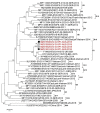Exploring the Cause of Diarrhoea and Poor Growth in 8-11-Week-Old Pigs from an Australian Pig Herd Using Metagenomic Sequencing
- PMID: 34452472
- PMCID: PMC8402840
- DOI: 10.3390/v13081608
Exploring the Cause of Diarrhoea and Poor Growth in 8-11-Week-Old Pigs from an Australian Pig Herd Using Metagenomic Sequencing
Abstract
Diarrhoea and poor growth among growing pigs is responsible for significant economic losses in pig herds globally and can have a wide range of possible aetiologies. Next generation sequencing (NGS) technologies are useful for the detection and characterisation of diverse groups of viruses and bacteria and can thereby provide a better understanding of complex interactions among microorganisms potentially causing clinical disease. Here, we used a metagenomics approach to identify and characterise the possible pathogens in colon and lung samples from pigs with diarrhoea and poor growth in an Australian pig herd. We identified and characterized a wide diversity of porcine viruses including RNA viruses, in particular several picornaviruses-porcine sapelovirus (PSV), enterovirus G (EV-G), and porcine teschovirus (PTV), and a porcine astrovirus (PAstV). Single stranded DNA viruses were also detected and included parvoviruses like porcine bocavirus (PBoV) and porcine parvovirus 2 (PPV2), porcine parvovirus 7 (PPV7), porcine bufa virus (PBuV), and porcine adeno-associated virus (AAV). We also detected single stranded circular DNA viruses such as porcine circovirus type 2 (PCV2) at very low abundance and torque teno sus viruses (TTSuVk2a and TTSuVk2b). Some of the viruses detected here may have had an evolutionary past including recombination events, which may be of importance and potential involvement in clinical disease in the pigs. In addition, our metagenomics data found evidence of the presence of the bacteria Lawsonia intracellularis, Brachyspira spp., and Campylobacter spp. that may, together with these viruses, have contributed to the development of clinical disease and poor growth.
Keywords: abundance; bacteria; disease; metagenomic sequencing; phylogenetic analysis; viruses.
Conflict of interest statement
The authors declare no conflict of interest. The funders had no role in the design of the study; in the collection, analyses, or interpretation of data; in the writing of the manuscript; or in the decision to publish the results.
Figures



Similar articles
-
The Novel Porcine Parvoviruses: Current State of Knowledge and Their Possible Implications in Clinical Syndromes in Pigs.Viruses. 2023 Dec 9;15(12):2398. doi: 10.3390/v15122398. Viruses. 2023. PMID: 38140639 Free PMC article. Review.
-
Viral metagenomics analysis demonstrates the diversity of viral flora in piglet diarrhoeic faeces in China.J Gen Virol. 2014 Jul;95(Pt 7):1603-1611. doi: 10.1099/vir.0.063743-0. Epub 2014 Apr 9. J Gen Virol. 2014. PMID: 24718833
-
Development of an EvaGreen-based multiplex real-time PCR assay with melting curve analysis for simultaneous detection and differentiation of six viral pathogens of porcine reproductive and respiratory disorder.J Virol Methods. 2014 Nov;208:56-62. doi: 10.1016/j.jviromet.2014.06.027. Epub 2014 Aug 4. J Virol Methods. 2014. PMID: 25102430
-
Do porcine parvoviruses 1 through 7 (PPV1-PPV7) have an impact on porcine circovirus type 2 (PCV2) viremia in pigs?Vet Microbiol. 2020 Mar;242:108613. doi: 10.1016/j.vetmic.2020.108613. Epub 2020 Feb 17. Vet Microbiol. 2020. PMID: 32122579
-
Occurrence and investigation of enteric viral infections in pigs with diarrhea in China.Arch Virol. 2013 Aug;158(8):1631-6. doi: 10.1007/s00705-013-1659-x. Epub 2013 Mar 15. Arch Virol. 2013. PMID: 23494226 Review.
Cited by
-
Experimental infection of high health pigs with porcine circovirus type 2 (PCV2) and Lawsonia intracellularis.Front Vet Sci. 2022 Oct 6;9:994147. doi: 10.3389/fvets.2022.994147. eCollection 2022. Front Vet Sci. 2022. PMID: 36277064 Free PMC article.
-
Mining Porcine Blood Whole-DNA Sequencing Datasets to Uncover Pig Viromes: An Exploratory Application to Identify Potential Infecting Agents of an Undefined Disease Outbreak.Vet Sci. 2025 May 24;12(6):513. doi: 10.3390/vetsci12060513. Vet Sci. 2025. PMID: 40559750 Free PMC article.
-
The Novel Porcine Parvoviruses: Current State of Knowledge and Their Possible Implications in Clinical Syndromes in Pigs.Viruses. 2023 Dec 9;15(12):2398. doi: 10.3390/v15122398. Viruses. 2023. PMID: 38140639 Free PMC article. Review.
-
Detection and genetic characterization of enteric viruses in diarrhoea outbreaks from swine farms in Spain.Porcine Health Manag. 2023 Jun 22;9(1):29. doi: 10.1186/s40813-023-00326-w. Porcine Health Manag. 2023. PMID: 37349807 Free PMC article.
-
First Molecular Characterisation of Porcine Parvovirus 7 (PPV7) in Italy.Viruses. 2024 Jun 8;16(6):932. doi: 10.3390/v16060932. Viruses. 2024. PMID: 38932224 Free PMC article.
References
-
- Sjolund M., Zoric M., Wallgren P. Financial impact on pig production III: Gastrointestinal disorders; Proceedings of the 6th European Symposium of Porcine Health Management; Sorrento, Italy. 7–9 May 2014.
-
- Dufresne L. Economics of Pig Health Improvements. [(accessed on 10 June 2021)]; Available online: https://porkgateway.org/wp-content/uploads/2015/07/economics-of-pig-heal....
Publication types
MeSH terms
LinkOut - more resources
Full Text Sources
Medical
Miscellaneous

